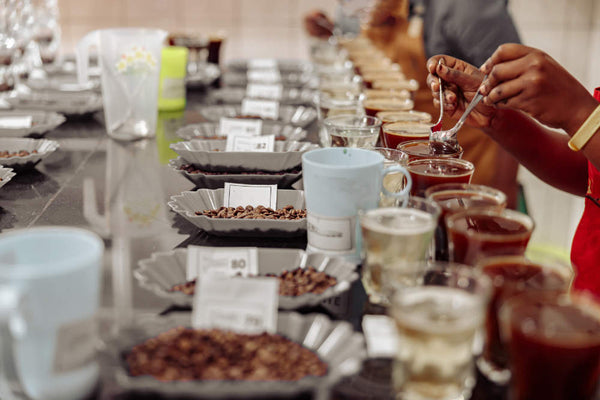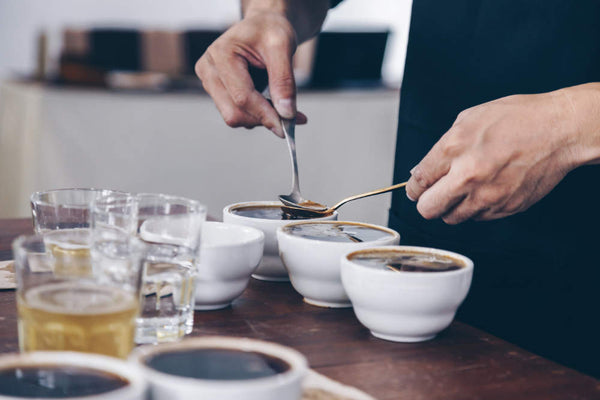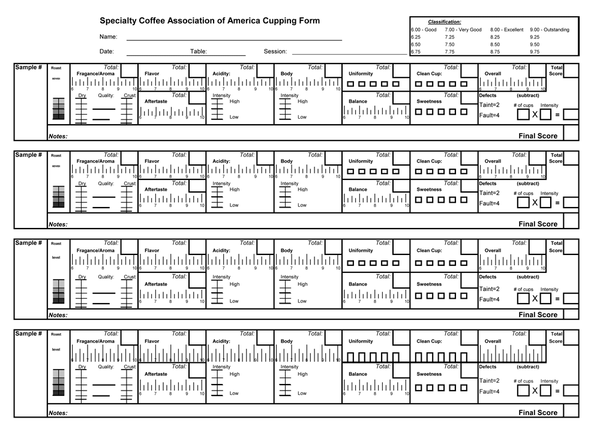Cupping is a universal approach that provides insight into the quality and taste of coffee before buying, roasting, or judging. It helps experts at Specialty Coffee Association (SCA), as well as Coffee Quality Institute (CQI), assess whether to bestow specialty grade on any given variety. Through cupping, specialists gain a better understanding of the flavor characteristics of each type of bean used for production.
Here, we discuss the details of cupping and its importance in professional coffee tasting. Not only do roasters use this technique to ensure quality roast each day, but cafe owners regularly practice it as well to further develop their barista's taste experience. Even you can benefit from learning how to cup at home too, with that knowledge under your belt, you'll understand coffee better and be able to find your favorite varieties much more quickly!
Why cupping

Cupping is the means to identify a coffee's flavor profile. This process involves brewing ground coffee in a cup with hot water and letting it steep for four minutes, allowing its taste and aroma characteristics to fully emerge.
Alternative brewing techniques may cause coffee to become more acidic or tart, as each technique reveals its unique flavor profile. Therefore, it is impossible to compare coffees prepared in different methods and assign a classification accordingly.
Cupping aids in elevating taste bud sensitivity. As you experiment with different types, pay attention to the flavor and aroma, and start recognizing subtle nuances within the aromas--you will be able to detect between flavors like nuts, flowers, berries, or fruits, as well as determine which region a coffee might come from purely by tasting it!
To do cupping, you need:
- coffee
- grinder
- cups
- spoon
- hot water
Lightly roasted coffee is ideal for cupping, as it should be ground to a coarser consistency than espresso - much like one would use for pour-over or Aeropress. To create 6.5 fl oz (200 ml) of the test coffee cup, 11 grams of the grounded coffee is needed.
GRINDING SIZE FOR CUPPING IS SIMILAR TO POUR-OVER
When everything is ready, you can start cupping. We recommend that you keep a notepad or evaluation sheet nearby and note what aroma and taste you felt:
Step 1: Smell test. To get a better understanding of the aroma, pour different varieties of coffee into separate cups. Give each cup a slight shake and bring it close to your nose. See if you can detect any distinct scents - like nuts, chocolate, or flowers for example - coming from the coffee beans themselves.
THE CLOSER YOU ARE TO THE CUP, THE BETTER THE FLAVOR IS FEELING
2. In a circular motion, pour hot water at a temperature of about 200°F (93°C) into cups with coffee. A coffee crust should form on the surface. Leave the coffee for four minutes to brew.
IT IS MORE CONVENIENT WHEN WATER IS FILLED TO THE EDGE OF THE CUP

3. After the brew is finished, it's time to break the crust and evaluate its aroma. To do this, approach the cup with a spoon angled at 70-80 degrees and use three or four swipes to move any remaining foam on top of your coffee toward one side of your cup. Upon doing so, you will be able to smell all the delightful aromas that were hidden under the crust. Aromas may vary - some might become more noticeable while others vanish into thin air - but understanding how each corresponding flavor can influence one another is key for mastering anyone’s favorite beverage: coffee.
IT IS IMPORTANT TO “CATCH” THE FLAVOR IMMEDIATELY AFTER BREAKING THE CRUST

4. After removing the crust, some foam will remain on the surface, it must be removed with a spoon. Let the coffee cool down for 8-10 minutes to about (158°F) 70 ºC. After that, evaluate the taste - scoop the drink into a spoon and suck it in sharply with your mouth. So that coffee spreads throughout the mouth - this will help to feel the full picture of taste.
TO FEEL BETTER DURING THE TASTING, WE RECOMMEND DO NOT SWALLOW, BUT SPIT THE COFFEE INTO A SEPARATE CUP
5. Note what you felt in the taste and taste the coffee in the remaining cup in the same way.
THAT FEELINGS ARE NOT FORGOTTEN, IT IS NECESSARY TO NOTE THEM

How to evaluate coffee
To determine the grade of coffee, tasters first must go through a program at the Coffee Quality Institute and pass 20 tests before receiving their certification. This process is primarily done by those whose profession consists of working with coffee, such as roasters or green suppliers. However, people who are more experienced in tasting without any sort of status may also partake in this evaluation practice.
If you only want to enhance the flavor of your coffee, it's not necessary to invest in CQI courses. All that needs doing is following procedure with accuracy and noticing how taste, aroma, acidity, body, balance, and aftertaste all play their part - along with any defects present.
Taste and aroma are judged by the purity and complexity of the descriptors - what can be felt in the coffee. They are fruity, floral, herbal, spicy, nutty, and more. A complete list of descriptors is indicated on the wheel of flavors and aromas.
Acidity is evaluated by intensity and quality. It should be sweet and pleasant.
The body is rated by its viscosity and excellence. Upon tasting, it should leave a delightful impression on the tongue. Balance can be evaluated through the general equilibrium of elements in combination with their complexity. A balanced cup does not possess extreme levels of bitterness or tartness for example.
The aftertaste of a product should match, if not exceed the overall taste in terms of purity, complexity, and duration. An optimal outcome would be for the aftertaste to remain pleasurable or even improve upon its original flavor.
Defects in coffee can create nasty flavors, such as earthy, moldy, herbaceous, and woody. To evaluate the quality of a given sample of coffee five cups are brewed from it and tasted for these defects. If none occur then the highest score is achieved, however, if even one cup has any defect present then points will be greatly deducted.
Evaluation sheet and coffee flavor wheel
To ensure an accurate evaluation of the flavor, utilize the official taste sheet and coffee flavor wheel.

Whether you use an evaluation sheet or simply jot down your thoughts in a notebook, tasting coffee can be made simpler and more organized. An assessment form is not necessarily required for noting what sensations are caused by each cup of coffee, however, it does make for a quicker way to record all pertinent information.
The Taste Wheel will help you refine your taste pallet and detect nuanced flavors. At first, it can be hard to tell apart a lemon from an orange since all citrus fruits are sour in flavor, yet when given enough practice the distinctions become more evident. Gradually your experience with different tastes will expand until you can easily differentiate between them.

